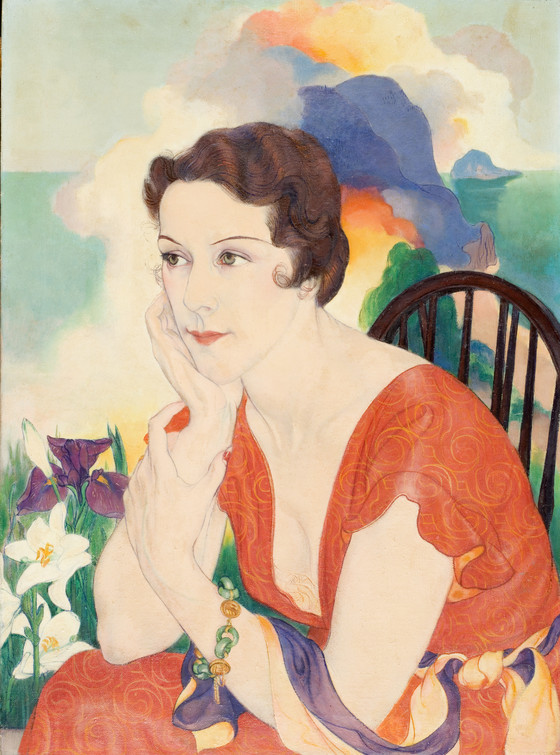This portrait is signed and dated on the reverse with the Japanese character meaning spring and portrays Stanton Macdonald-Wright's lover Riza Royce, née Riza Maria Marks (1902-1980)....
This portrait is signed and dated on the reverse with the Japanese character meaning spring and portrays Stanton Macdonald-Wright's lover Riza Royce, née Riza Maria Marks (1902-1980). Macdonald-Wright was deeply interested in the function of symbols and in myth and spirituality, and many such references surround his sensitive depiction of Royce. At the left are white lilies, symbols of purity and virtue, and irises, which are named for Iris, messenger of the gods in Greek mythology and the personification of the rainbow. The colors of the rainbow appear behind Royce's head in a mountainous landscape dominated by peaks of blue-violet, "the introspective, the inspirational color." The pattern of the red silk dress she wears repeats the yin-yang symbol, which represents the intertwining of the female principle, yin, with the male principle, yang, in Eastern philosophy. An actress of some renown, Royce had been married to prominent Hollywood producer Josef von Sternberg, and she and Macdonald-Wright were involved from the late 1920s through 1933. The increasing seriousness of his relationship with Royce impelled Macdonald-Wright to leave Los Angeles in May of 1932 for New York, where he joined Royce and painted this portrait.
In the painting Royce wears a jade bracelet that was a gift to her from Macdonald-Wright very early in their relationship. Reportedly carved from a single piece of jade (there are no seams in the circular pieces), the bracelet is also worn by Royce in a photograph of her taken about 1929-1930. In China, jade is revered for its beauty and spiritual qualities, and the bracelet was probably symbolic to both Macdonald-Wright and Royce on many levels. It descended in the family through their daughter, Linfa Riza Wright (1933-2001), who donated this painting and the three graphite drawings by her father to the museum. The family has always understood that Macdonald-Wright chose his daughter's name, Linfa, which is Chinese for Lotus flower and is another allusion to his abiding interest in the Far East.
From the exhibition Stanton Macdonald-Wright and His Circle at LACMA
January 29-May 28, 2003
More...
